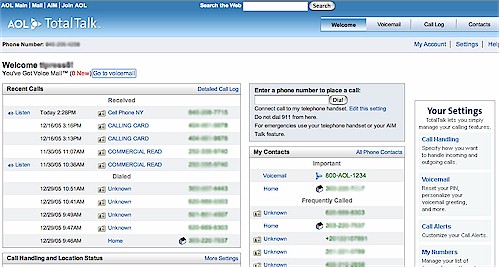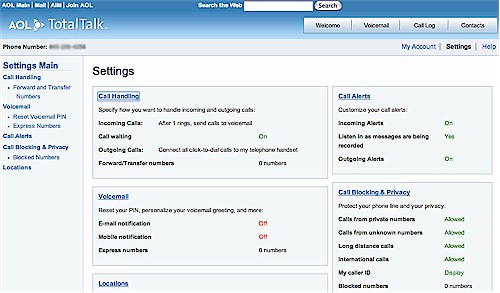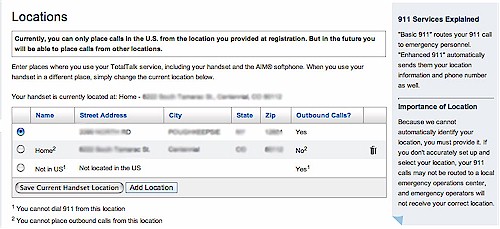Introduction

| AOL TotalTalk | |
|---|---|
| Summary | Broadband VOIP service from AOL. You do not need to be an AOL member |
| Update | None |
| Pros | • Easy to use web-based admin interface |
| Cons | • No bandwidth use adjustment • Unusable QoS feature in supplied router |
Voice over IP (VoIP) is hot these days; it seems like a bit of a forgone conclusion that eventually all calls will travel over a TCP/IP network. I’ve toyed with VoIP using Skype and audio iChat on my laptop, but there’s still something more appealing about having a real phone in your hand. Even at home, I feel a bit like a lunatic having a conservation with my computer.
And if that’s not bad enough, I recall the time I found an open access point in the baggage claim area of Seattle’s airport. Thinking I’d check in with my family while waiting for my luggage, I made an audio iChat call. So there I was in the noisy terminal, alternating between yelling at my laptop and holding the laptop speaker to my ear so I could hear – it wasn’t a pretty sight. I was lucky the sky marshals didn’t take me away for a little chat of their own…
A VoIP service that lets me use a standard phone and acts like a real phone service wouldn’t have made my airport experience any better, but it might be a good fit into my house, while also shaving a few bucks off my monthly phone bill. In this review, I’ll take a look at a VoIP offering from AOL that comes bundled with a combined router and access point from Netgear that allows use of a standard telephone. First I’ll look at the router, then I’ll try out the VoIP service.
Physically, NETGEAR’s WGR615V resembles their other wireless router offerings – it’s a slim silver box with rounded corners and a single antenna – but looking a bit closer reveals some differences. Two of the status LEDs on the front are labeled with telephone icons, and along with four Ethernet ports on the back, there were two RJ-11 ports (Figure 1). Another difference was a DB-9 connector covered with a plastic cap and a sticker : “Warning do not use”. Oooo, that’s interesting, I thought. I’ll have to come back to that later.

Figure 1: NETGEAR WGR615V back panel
Under The Covers
The NETGEAR WGR615V is very much a TI-based design, with the TNETV1060 CPE Gateway at its core (Figure 2). The chip integrates a programmable TMS320C55x DSP, MIPS32 4KEc processor, and Telogy VoIP software. The only other chip of note besides the RAM and flash is a Realtek RTL8309SB Single-Chip 9-port 10/100M Fast Ethernet Switch Controller. Given that the switch supports so many ports, it’s curious that NETGEAR brought out only three Ethernet LAN ports.
Figure 2: WGR615V board
(click image to enlarge)
The radio is a TI-based design, too, OEM’d from Sercomm. Figure 3 shows it uses TI’s 802.11g TNETW1130 / RC2422 / RC2326 solution comprised of a single chip MAC / baseband, Transceiver, and RF Front End respectively.

Figure 3: WGR615V radio
When I first received the box, I was quite surprised to see the DB-9 connector on the back. These ports are usually used by engineers during development, and it’s pretty uncommon to see them on a consumer product. I thought that perhaps I’d received a pre-release box with an engineering connector, or maybe just the first production batch had it left on. However, when I “Googled” the web, I found other pictures that also had the same connector.
Regardless of why it was there, the “danger” sticker was an irresistible beacon for me! Trying this port out was just a matter of the right cable, a dumb-terminal program, and a bit of trial-and-error for baud/parity etc. It turned out that it wanted a pretty standard 9600 baud, no parity and one stop bit. Using this setting, I was able to see VxWorks boot-up messages, some debug messages, and an attempt to acquire a new flash image via tftp. Playing with it a bit more, I found that when the network cable was unplugged, the box presented a user name and password prompt. I tried a few standard combinations but never had success. I suspect that with some more research on similar boxes, one could find the correct combination and explore further.
Setting Up
Once I fired up the router, configuration was fairly straightforward. A label on the bottom had the default IP address, along with the default administrator user name and password. Like most other units, configuration was accomplished using a web browser. When I connected my browser to the specified address, menus were available for basic network setup, such as static IP, dynamic IP, etc. Under basic wireless configuration, menus were available for setting the channel, wireless mode, SSID, and either WEP or WPA security.
One interesting feature was the ability to select your region. Instead of being hard-coded to the United States, Japan, Europe, or other location, the region could be changed. So, if you’re in the US and select a European region, two additional communication channels become available. But if you try to use these channels in the US, you’ll run afoul of FCC regulations, as a pop-up menu will warn you. A VoIP menu under setup showed static information about the state of the VoIP service.
Moving on, under a menu entitled “Content Filtering”, parental control type features were available that allowed blocking of sites based on domain name or keywords, and email alerts when the filters were triggered. In order to set up a test, I added “kitty” as a restricted keyword in order to block all access to “Hello Kitty” web pages. Attempting to visit hellokitty.com resulted in a denial, as shown in Figure 4, which was then followed by an alert email.

Figure 4: What happens when you try to hit a blocked website
Since the filter was only based on URL keywords, I was not prevented from visiting a web page that didn’t have “kitty” in the URL but still had Hello Kitty coloring sheets and text. If I wanted to block sites like this, I would have to explicitly add their domains. I also found that I could use an IP address instead of a named URL to access other Hello Kitty sites that should have been blocked; it was a losing cause. Parents shouldn’t rely on a feature like this to keep their kids away from the dangers of the saccharine-sweet Hello Kitty. (There was an additional menu available where I could have set up trusted IP addresses for older children who would perhaps be better able to handle the addictive Hello Kitty product line.)
Wrestling With QoS
The next menu in the list was “Maintenance”, which allowed me to check the status of the router as well as to back up my configuration and change the administrator password. Under the “Advanced” menu, there were a number of features available. Highlights included port forwarding, port triggering (Figure 5), DMZ, Dynamic DNS setup, and LAN DHCP setup.
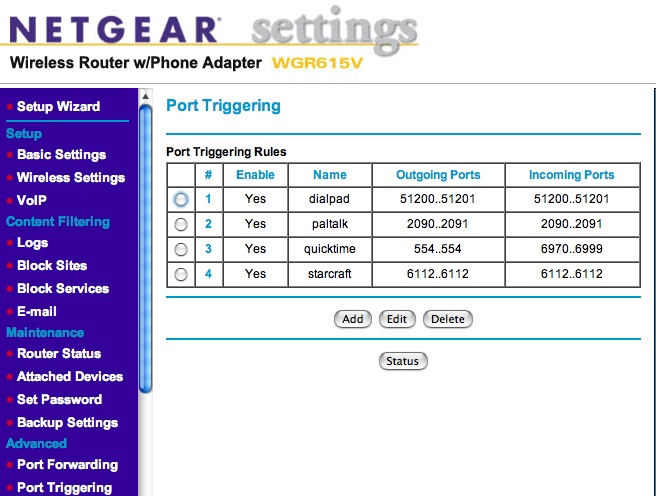
Figure 5: Port Triggering
Under WAN setup, I found the first configuration items related to VoIP usage: QoS and Bandwidth. The help text for QoS (which stands for “quality of service”) described it as a way to assign priority to voice traffic over data traffic, and specified that it should only be set “If you experience delays or drop-outs on VoIP calls”. Its default state was off, so I turned it on just to see what it would do. When I hit the “Apply” button, I got the pop-up shown in Figure 6. Evidently, turning on QoS also required me to set bandwidth, which in-turn had a relationship to the MTU setting which was also available in this menu.
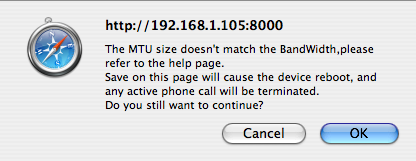
Figure 6: QoS warning
According to the help on the page, the MTU should be specified in Bytes, and the bandwidth should be specified in kiloBytes per second (KBytes/sec), but the label next to the Bandwidth field (Figure 7) indicated that the value entered should be specified in kbps, i.e. kilobits per second.
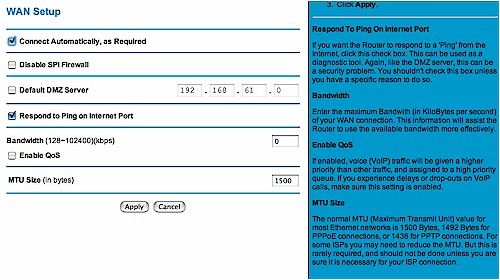
Figure 7: Bits or Bytes?
To enable to me to accurately fill out the form, I ran a speed test, which showed my highly asymmetric cable modem was giving me around 3900 kbps download and 354 kbps upload. Since my upload speed was going to be the limiting factor, I used that value for my bandwidth. I first attempted to enter 354 (kbps) for bandwidth, but a pop-up complained that the value didn’t match my MTU. Next I attempted to enter 44 (KBps) but a pop-up complained that the value had to be greater than 127.
Digging a little deeper to see just what NETGEAR wanted in this menu, I viewed the HTML source for the page. It revealed that NETGEAR had commented out pop-up suggestions on what values to enter for MTU based on your bandwidth. Instead they just put in directions indicating that you should see the Help page. When I looked at the help, it suggested that the MTU should not be changed at all “unless you are sure it is necessary for your ISP connection”.
So it boils down to that fact that turning on QoS requires you to make sure your Bandwidth setting (measured in either KBps or Kbps), matches up with your MTU setting (measured in Bytes). Your Bandwidth is a fixed value reflecting your ISP account, and you are advised not to change the default MTU. I, uh, think there’s room for improvement here. I left QoS turned off, and moved on.
Routing Performance
If you need a router capable of handling a Fiber To The Home (FTTH) Internet connection, then the WGR615V isn’t for you.
Routing Performance Test results
| Firmware Version: | Not recorded | |||
| Test Description |
Transfer Rate (Mbps) |
Response Time (msec) |
UDP stream (1000kbps rate) |
|
| Throughput (kbps) |
Lost data (%) |
|||
|
WAN-LAN |
25 |
11 (avg) |
887 |
2.5% |
|
LAN-WAN |
26 |
11 (avg) |
N/A |
N/A |
[Details of how we test can be found here.]
Not that its ~25Mbps up and downlink throughput is bad, mind you. But many current-generation consumer routers are providing wire-speed 100Mbps routing. It’s also unusual to see Response (ping) times about 1msec or so. So the 11 msec times are a bit odd.
UDP streaming performance will handle VOIP calls just fine. But if you’re going to be watching streaming video at rates above 500kbps or so, you may have picture breakup problems.
TotalTalk – Setting Up
At this point, the router was configured and running on my network, so it was time to really check out VoIP. AOL TotalTalk has three different levels of service (Figure 8). At the low end, you can get unlimited local calling with 3.9 cents a minute long distance; this will set you back $18.99 a month. The middle offering, at $29.99 a month, offers unlimited domestic long distance within the US and Canada. At the high end, for $34.99 a month, you can get the same unlimited long distance, plus support for international calls, the toll of which will vary depending on the country you call. All prices are before tax and fees – these add up just like they do with standard phone service.

Figure 8: TotalTalk Plans
The instructions indicated that to fully utilize the VoIP features of the service, I needed to install the latest Beta version of the AIM Triton service. Thus, off I went to beta.aol.com, to find the software for installation on my XP laptop. Installing the software involved the standard process of downloading and running an executable program, agreeing to multiple Terms of Service, telling it not to install an AOL toolbar on Internet Explorer, not to change my home page, not to change my default browser, not to install a plaxo.com integrated address book, and so forth.
After the installation completed, I had new shortcuts on my desktop for “Free AOL With SPAM Blocker!”, “AOL Explorer Browser”, “AIM Triton”, etc. When I started up the AIM Triton software and logged in, the AOL Explorer Browser was spawned and I was greeted with a full-page animated advertisement for Ford. This I closed immediately. Then I noticed that the AIM client itself was also displaying ads as part of its display. At one point, while exploring the options, I was greeted with a poor quality, loud, grating audio clip of Jingle Bells.
My first thought was that I had contracted a virus while installing all of the AOL software, and it was taunting me. But then I realized that I was being annoyed courtesy of an ad running inside the AIM client itself. Nice. As I continued exploring, nothing seemed related to my VoIP service, until I selected the “Dashboard” option. This kicked off the AOL Explorer Browser once more and directed it to a totaltalk.com web page detailing the status and settings of my VoIP service. This was where the real configuration and status checks were done. Once I verified that I could access this same web page with my own browser, and I verified that there were no more VoIP options in the Triton client, I retreated to my iBook – where I could work without being assaulted by noisy, full-screen animated ads.
TotalTalk – In Use
I browsed through the status web pages, and from what I could tell, everything appeared to be set up, so I plugged in a standard telephone and lifted the receiver. I had a dial tone; cool. (The NETGEAR router had come already set up for accessing the TotalTalk service, so I can’t share what that experience was like. If it’s like other services, though, it probably isn’t that difficult.)
I made a couple of local calls and judged the quality. Both I and the party on the other end judged the quality to be as good as a standard call. To give the system a bit more of a workout, I made a long distance call to my parents. This went through without issue, and my father said that I sounded even clearer than normal. To really give the service a stress test, I set out to call my globetrotting brother, who currently finds himself living with his family in Cairo, Egypt. This failed, with a recording indicating that my settings were blocking international calls. I thought that perhaps the service authorized for this review did not allow outgoing international calls, so I sent my brother an email with the phone number of my VoIP asking him to call me instead. After a few minutes, the phone rang and I was talking to my brother.
Based on the advice of other expatriates whom he works with, my brother has been using Skype for his international calls; he finds it much cheaper than using a standard service. This means that during our conversation, my brother was on Skype and I was on Totaltalk. As we talked, I judged the quality to be pretty good, but there was a definite lag of a half second or so that made conversation a little bit difficult. I’ve encountered this before when talking to him, so instead of any issue with VoIP, it’s probably more an indication that the signal was traveling over a satellite somewhere along the line.
Another thing I noticed was a faint background conversation. I asked my brother if this was typical of his international calls, but he indicated that what I was really hearing was his wife in the next room, talking to her Baghdad office via cell phone. This told me that the quality of the service was good enough for low-level audio. It also helped me realize that a lot of things have changed since my brother and I grew up in a small Kansas town!
A day or so later, I thought I’d push the service to the limit. Once again I made a long distance call to my father, but after I established the connection, I opened my laptop and simultaneously sent an email with a 4 MB attachment. Almost immediately, the conversation started breaking up – so much so that it was practically unusable. I waited a bit for the email to finish, hoping that the quality would pick back up, but even after the email was sent, the quality remained poor. It may have eventually recovered, but I got tired of waiting, hung up, rebooted the router and called back.
Along those same lines, I attempted to send a fax out over the VoIP line while my kids were casually browsing the web. The fax started to go, but eventually quit with an error indicating poor line quality. I tried again when our Internet line was idle and this time the fax went through.
These two tests show that users of a VoIP line will need to remember that they’re using a shared medium. If I could have gotten the QoS setting to work, it may have helped my VoIP connection, but it would have been at the expense of other users of the line.
TotalTalk – Advanced Features
Now that I had verified the basic operation of the service, I turned to exploration of the advanced options and settings available from the web interface. The basic screen displayed after logging in to the TotalTalk web site showed a summary of both my incoming and my outgoing calls, along with an address book (Figure 9).
Figure 9: TotalTalk Welcome Screen
(click image to enlarge)
This screen also contained a form for dialing a number, which I thought was a bit curious. How could a form on a web page dial my telephone for me? But a little investigation and a test showed that what really happened was a two step process. When I submitted a number to dial, first the AOL server would “ring” my phone, and then when I picked it up, the submitted number would be called. This was a bit different than “normal” usage, but it worked well and was handy. It sort of reminded me of the old-fashioned phone systems you see in the movies where the operator would dial a long distance number and then call you back when the connection was made.
Browsing through the various pages on the web site, I found an extensive set of options (Figure 10). I could set up call forwarding, define the behavior of voice mail, and turn on call-waiting. I could listen to my voice mail or even download it as MP3 files. I also found an option for blocking long distance and/or international calls. When I enabled international calls, I was able to call my brother on his cell phone in Cairo. This time the quality was very poor, but it was probably due to spotty cell coverage on his end.
Figure 10: Call Handling screen
(click image to enlarge)
An interesting setting was the one for 911 service (Figure 11). Nationwide, there have been a number of problems with people trying to call 911 when on a VoIP phone. The settings on this page allow you to define locations where the phone was to be used. The idea was that you would update your location whenever the phone was moved, in order to properly handle 911 calls. The page specified that only your “home location” could be used for outgoing calls, but there was really nothing to keep you from moving the phone from place to place without making a change on this page.
Figure 11: Specifying 911 Locations
(click image to enlarge)
I used the phone in a couple of different states without issue, although if I had made a 911 call it would have been routed to the wrong place. I did notice that after leaving the phone powered off for a while – such as during a move – that when I turned it back on, it would ask me to verify that it was still located at its “home” location. The few times this happened after I had moved the phone, I “lied”, by acknowledging it was in the same place, and it worked fine.
Closing Thoughts
I found the NETGEAR box to be a nice access point and router with a fair level of functionality. It did what it was designed to do and the basic functions worked well. I also enjoyed using AOL’s TotalTalk service; under normal usage, I had high-quality voice service with a large number of features such as caller ID, voice messaging and call forwarding.
Where TotalTalk gave me trouble was with its shared usage of my Internet connection. For this reason, I’d be hesitant to rely on it as my only phone. Also, standard phone service will work when the house power is off, but since VoIP service relies on a powered router, you wouldn’t be able to use it during a power outage.
I also didn’t enjoy almost thinking my computer had been infected by a virus after I dutifully loaded the AOL Triton client. Since this step proved to be unnecessary, I hope AOL revises the installation instructions so that users won’t have to install yet another application on their systems whose main purpose is to deliver advertising. After all, TotalTalk is a pay-for service!
The cost of the service compares well to standard service if you need all of the extra features, but not as well if all you need is a dial tone. Thus, I’ll be sticking with my standard phone service, but I’ll keep my eye on the developing VoIP market. It doesn’t meet my needs yet, but I believe its time will come.


